Uneven lies such as uphill, downhill and sidehill pose a serious challenge to golfers unlike hitting from a flat lie on the fairway.
In order to improve your game, you must learn how to master each of these shots as almost all golf courses will have challenging uphill, downhill and sidehill lies.
In this article we will discuss how to hit a a golf ball on uneven lies and the adjustments you need to take. Let’s take a look at each.
Table of Contents
How To Hit From A Uphill Lie?
Getting the ball into the air is usually not a problem from an uphill lie. But because the ground you’re standing on is sloping upward, you will need to change your stance, alignment, and swing accordingly. You also need to consider the distance a shot travels when it is hit uphill.
Make Adjustment For An Uphill Lie
When the ball is positioned on an uphill lie, you need to make the following adjustments:
- Stand with your shoulders and hips parallel to the upward slope; your left shoulder will naturally be higher
than your right shoulder. 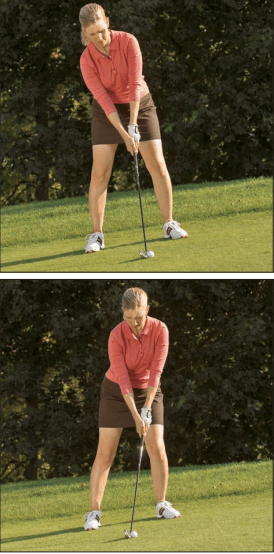
- You don’t want to keep your shoulders level or tilt them in the opposite direction of the slope. If you do so, you will likely lose your balance during the swing, and the club might hit the ground first, likely causing a fat shot.
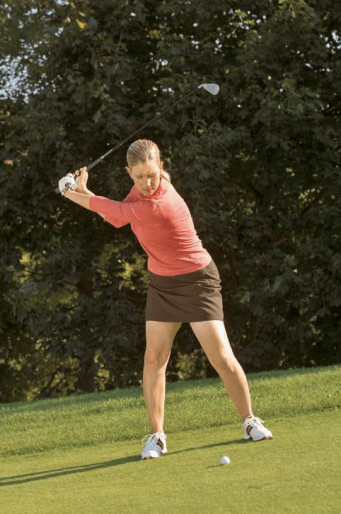
- Position the ball more toward your front foot.
- Balls hit off an uphill slope tend to go left, so aim to the right of your target. That happens because it’s difficult to
turn the lower body properly on this type of lie, therefore your arms and hands get ahead of your body earlier than normal, which causes the clubface to close. - Use a less lofted club than you normally would for the distance; the ball will naturally fly higher because of the
uphill slope. - Grip down on the club.
- Feel as if you are swinging along the slope—don’t hit into it. Your backswing should feel like it is going down
the slope, while your downswing is moving up it. - When judging the distance you have to hit the ball in this situation, expect a higher trajectory and less roll. To adjust for that, be sure to pick a landing area close to your target.
How To Hit From A Downhill Lie?
Your ball may come to rest in a downhill lie. Because the ground you’re standing on will be sloping downward, you will have to alter your normal stance, alignment, and swing, plus take into account the distance a shot from this lie will travel.
Make Adjustment For A Downhill Lie
When the ball is positioned on a downhill lie, you need to make the following adjustments:
- Stand with your shoulders and hips parallel to the downward slope; your right shoulder will naturally be
higher than your left shoulder. - You don’t want to keep your shoulders level or tilt them in the opposite direction of the slope. If you do so, you will likely lose your balance during the swing.
- You might also top the ball, since your shoulders won’t be level with the downhill slope and the club might bottom out early, hitting the top of the ball on the upswing instead of catching it cleanly.
-
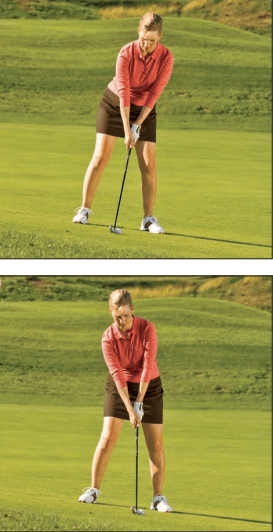
- Position the ball more toward your back foot.
- Balls hit off a downhill slope tend to go right, so aim to the left of your target.
- To help increase the trajectory of the ball, use a more lofted club than you normally would for the distance.
- Expect the ball to roll farther than normal because the ball will fly lower than normal from this lie. Be sure to pick a landing area short of your intended target to allow for the extra roll.
- Grip down on the club.
- Take a limited backswing—approximately three-quarters of a full backswing. Feel as if you are swinging the club up the hill on the backswing and down the slope on the downswing.
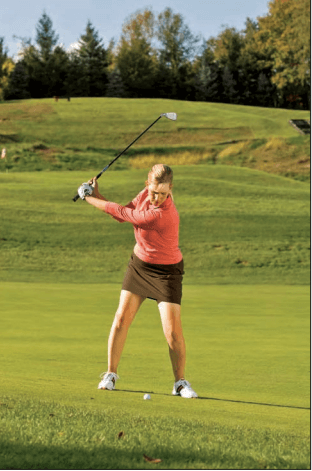
How To Hit From A Sidehill?
When your ball ends up on a sidehill lie, it is positioned either above or below your feet. Either way, the ball not being level with your feet will directly impact your stance, alignment, and swing and the direction of your shot.
Since it’s rare that you are able to practice hitting from such a lie, understanding the adjustments you need to make will make this seemingly difficult shot a bit easier to play.
When The Ball Is Above Your Feet
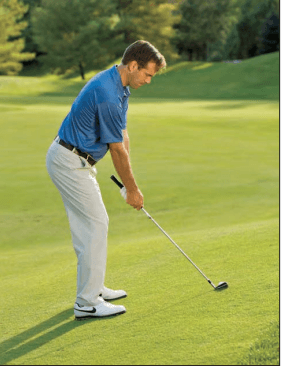
When the ball is positioned above your feet, you need to make the following adjustments:
- Use a more lofted club than you normally would for the yardage you are trying to hit, because this lie produces a right-to-left draw shot that will roll farther than a typical shot. For example, if you would normally hit a 6-iron, opt for a 7-iron instead.
- Aim to the right of your target, since the uphill slope will make your shot move to the left.
- Position the ball more toward your back foot when you take your stance.
- Stand tall when addressing the ball, and keep your weight on the balls of your feet to help maintain balance through the swing.
- Grip down on the club. How far down depends on the severity of the lie—the steeper the incline, the farther down you should grip.
Take a practice swing and hit the ground to find out how far you need to bend over and how much to grip down on the club. - Make a flatter swing, with your arms lower than usual at the top of the backswing. This type of swing produces draws and the potential for hitting a fat shot. (That’s why you place the ball back in your stance and aim right of your target.)
When The Ball Is Below Your Feet
This is the most difficult lie to play from because it has the greatest potential for a topped shot (where the clubface hits the top of the ball). When the ball is positioned below your feet, you need to make the following adjustments:
- Use a less lofted club than you normally would for the yardage you are trying to hit, because this lie puts a side spin on the ball that produces less roll. For example, if you would normally hit a 9-iron, try an 8-iron instead.
- Aim to the left of your target, since the downward slope will produce a fade-shaped shot that moves from left to right.

- Where you place the ball in your stance depends on which club you are using. For an 8-iron through sand wedge, place it in the middle; for a fairway wood, place it just left of center. Take a practice swing first and hit the ground to find out where the swing will bottom out—this will help ensure that you make good contact with the ball.
- Widen your stance and keep your weight back toward your heels to maintain balance throughout the swing.
- Grip the club as close to the end as you can.
When the ball is below your feet, your swing should be more upright than usual. Your arms and hands go up a little higher than normal during the backswing, and then back down to the ball. This more upright swing makes it easier to hit down on the ball and make a divot. It can also lead to an open clubface, which is why you want to aim left of the target.




